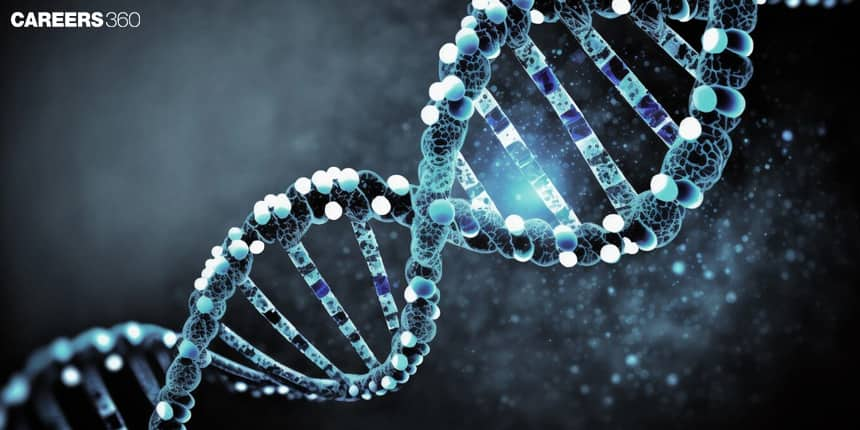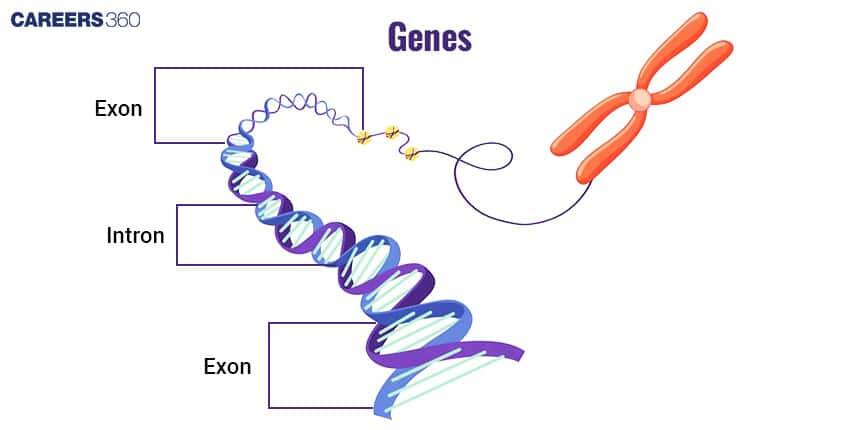Genes: Definition, Structure, Expression, Facts, Characteristics, Functions
A gene, in biology, is the fundamental unit of heredity found in the DNA of living organisms. It consists of specific sequences of nucleotides that determine its structure with regions such as exons, introns, and regulatory elements. The function of a gene is to encode proteins or RNA molecules that are very fundamental for biological processes. A gene in class 9 and class 10 biology was defined as a DNA segment that controls the traits by regulating the synthesis of proteins. This is one of the important topics in biology which links major chapters.
NEET 2025: Mock Test Series | Syllabus | High Scoring Topics | PYQs
NEET Important PYQ's Subject wise: Physics | Chemistry | Biology
New: Meet Careers360 B.Tech/NEET Experts in your City | Book your Seat now
- What are Genes?
- Characteristics Determined by Genes
- Structure of Gene
- Function of Genes
- Gene Expression and Regulation

What are Genes?
Genes are considered an integral part of the heredity of any living organism. It is simply a part of DNA with one or more genes, which holds instructions needed to build and maintain cells and transfer that genetic material to the next generation.
The concept of a gene developed in the 19th century, though it began with Gregor Mendel. Mendel's pea plant experiments gave the very fundamentals of genetic inheritance that were later built upon by James Watson and Francis Crick, They described the structure of DNA in 1953.
Genes are responsible for determining the physical and functional features of organisms. They control everything from eye colour to a predisposition to certain diseases thus lying at the very core of biological research and medical study.
Also Read
Characteristics Determined by Genes
Genes determine a broad spectrum of characteristics from physical to biochemical processes and behavioural framing. That is, from height to each eye colour. This genetic blueprint, the aggregate of information, is inherited from parents and shapes the unique combination of traits in each individual.
Reasons for Hereditary
Heredity refers to the transmission of characteristics from parents to their offspring through genes. In reproduction, genes mix and shuffle, creating diversity as well as maintaining the continuity of the features that govern a particular species. The heredity system ensures that the trait is transmitted from both parents to the offspring.
Structure of Gene
DNA and RNA Complex: Genes comprise DNA which stands for deoxyribonucleic acid, an acid containing genetic information. RNA stands for ribonucleic acid, important in translating information into proteins.
Nucleotides: The two nucleic acids DNA and RNA are composed of nucleotides, each consisting of a sugar molecule, a phosphate group, and a nitrogenous base. It is the sequence of the latter that carries the genetic information.
Organisation of Genes: Genes have exons and introns, in which the exons are portions of a gene that encode the central dogma and become part of the mature mRNA. The introns might be several thousand nucleotides that interrupt the coding sequence and are removed in the process of RNA maturation.
Diagram: Gene Structure
The diagram below shows the structure of genes with their components

Function of Genes
The function of genes can be defined as:
Transcription and Translation
Proteins are synthesised by the genes through two principal processes: transcription, which copies genetic information from DNA to mRNA, and translation, where appropriate proteins are assembled with the genetic information on mRNA.
Role of Genes in Protein Synthesis
The genes describe ways for assembling amino acids into line sequences of particular proteins carrying out cells' structural and functional roles.
Genetic Code
A set of rules whereby information in DNA is translated into proteins. The code consists of a sequence of nucleotide triplets called codons that each represent a specific amino acid.
Gene Expression and Regulation
Gene Expression Basics: Gene expression refers to the process of activation of a gene in the expression of its protein. This is highly regulated so that appropriate proteins are made at appropriate times and in appropriate quantities.
Factors that Affect Gene Expression: Gene expression can be taken to the influence of environmental signals, development, and immediate cellular conditions. To this end, regulatory proteins and sequences are equally important.
Epigenetics: By this term, it is referred to the heritable changes in gene activity not resulting in changes to the DNA sequence. This can often cause changes due to chemical modifications of either DNA itself or histones. Occasionally, the process is influenced by environmental factors.
Also Read
Video Recommended on Genes
Frequently Asked Questions (FAQs)
It is that segment of DNA containing the needed information for making proteins, which perform different functions in the body. Genes work by being transcribed into mRNA and then translated to protein.
Structural genes coding for proteins, regulatory genes that turn on and off gene expression, and housekeeping genes involved in basic cellular functions.
One mutation can alter the nucleotide sequence of a gene; sometimes it will then produce an altered protein. This could result in malfunctioning proteins causing diseases or may have no effects or even be beneficial.
Gene expression is the process by which the information in a given gene is used in the synthesis of proteins. It is regulated by several elements, such as transcription, epigenetic changes, and environmental signals.
Techniques include CRISPR-Cas9 for the precision editing of genes, gene cloning to produce multiple copies of genes, and recombinant DNA technology for gene transfer into new organisms.
Also Read
29 Nov'24 09:31 AM
19 Nov'24 09:26 AM
18 Nov'24 06:45 PM
18 Nov'24 09:29 AM
18 Nov'24 09:18 AM
18 Nov'24 09:01 AM
18 Nov'24 08:37 AM
16 Nov'24 03:45 PM